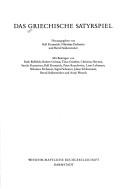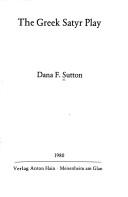| Listing 1 - 10 of 20 | << page >> |
Sort by
|
Book

ISBN: 9783110725230 9783110725216 3110725231 3110725215 Year: 2021 Publisher: Berlin Boston
Abstract | Keywords | Export | Availability | Bookmark
 Loading...
Loading...Choose an application
- Reference Manager
- EndNote
- RefWorks (Direct export to RefWorks)
The origins of satyr drama, and particularly the reliability of the account in Aristotle, remains contested, and several of this volume’s contributions try to make sense of the early relationship of satyr drama to dithyramb and attempt to place satyr drama in the pre-Classical performance space and traditions. What is not contested is the relationship of satyr drama to tragedy as a required cap to the Attic trilogy. Here, however, how Aeschylus, Sophocles, and Euripides (to whom one complete play and the preponderance of the surviving fragments belong) envisioned the relationship of satyr drama to tragedy in plot, structure, setting, stage action and language is a complex subject tackled by several contributors. The playful satyr chorus and the drunken senility of Silenos have always suggested some links to comedy and later to Atellan farce and phlyax. Those links are best examined through language, passages in later Greek and Roman writers, and in art. The purpose of this volume is probe as many themes and connections of satyr drama with other literary genres, as well as other art forms, putting satyr drama on stage from the sixth century BC through the second century AD. The editors and contributors suggest solutions to some of the controversies, but the volume shows as much that the field of study is vibrant and deserves fuller attention.
Greek drama (Satyr play) --- Satyric drama, Greek --- Dionysia --- Greek drama
Book
ISBN: 9027978441 3110801825 9783110801828 9789027978448 Year: 1978 Volume: 16 Publisher: The Hague : Mouton,
Abstract | Keywords | Export | Availability | Bookmark
 Loading...
Loading...Choose an application
- Reference Manager
- EndNote
- RefWorks (Direct export to RefWorks)
Sinceits founding by Jacques Waardenburg in 1971, Religion and Reason has been a leading forum for contributions on theories, theoretical issues and agendas related to the phenomenon and the study of religion. Topics include (among others) category formation, comparison, ethnophilosophy, hermeneutics, methodology, myth, phenomenology, philosophy of science, scientific atheism, structuralism, and theories of religion. From time to time the series publishes volumes that map the state of the art and the history of the discipline.
Dionysia --- 292.1 --- 292.1 Godsdiensten van de Grieken --- Godsdiensten van de Grieken --- Orphic mysteries --- Orphism --- Cults --- Dionysia.
Book
ISBN: 1282716263 9786612716263 3110216604 9783110216608 3110206331 9783110206333 9783110206333 3110482355 9781282716261 Year: 2010 Publisher: Berlin ; New York : Walter de Gruyter,
Abstract | Keywords | Export | Availability | Bookmark
 Loading...
Loading...Choose an application
- Reference Manager
- EndNote
- RefWorks (Direct export to RefWorks)
Many recent discoveries have confirmed the importance of Orphism for ancient Greek religion, philosophy and literature. Its nature and role are still, however, among the most debated problems of Classical scholarship. A cornerstone of the question is its relationship to Christianity, which modern authors have too often discussed from apologetic perspectives or projections of the Christian model into its supposed precedent. Besides, modern approaches are strongly based on ancient ones, since Orpheus and the poems and mysteries attributed to him were fundamental in the religious controversies of Late Antiquity. Both Pagan and Christian authors often present Orphism as a precedent, alternative or imitation of Chistianity.This free and thorough study of the ancient sources sheds light on these controversial questions. The presence of the Orphic tradition in Imperial Age, documented by literary and epigraphical evidence, is confronted with the informations transmitted by Christian apologists on Orphic poems and cults. The manifold Christian treatments of Pagan sources, and their particular value to understand Greek religion, are illuminated by this specific case, which exemplifies the complex encounter between Classical culture and Jewish-Christian tradition.
Christianity and other religions --- Dionysia. --- Orphic mysteries --- Orphism --- Cults --- Dionysus. --- Orpheus. --- Orphism (Religion). --- Reception (Religion).

ISBN: 0891301194 9780891301196 Year: 1977 Volume: 12 4 Publisher: Missoula (Mont.): Scholars Press,
Abstract | Keywords | Export | Availability | Bookmark
 Loading...
Loading...Choose an application
- Reference Manager
- EndNote
- RefWorks (Direct export to RefWorks)
Hymns, Greek (Classical) --- Orphic hymns --- Dionysia --- 875 --- Greek hymns --- Orphic mysteries --- Orphism --- Cults --- Griekse literatuur --- Orphic hymns. --- Dionysia. --- 875 Griekse literatuur --- Hymns, Greek (Classical). --- 875 Greek literature --- Greek literature --- Hymns, Greek (Classical) - Translations into English --- Orphic hymns - Translations into English
Book
ISBN: 9789004384842 9004384847 9789004384859 9004384855 Year: 2019 Publisher: Leiden ;Boston Brill
Abstract | Keywords | Export | Availability | Bookmark
 Loading...
Loading...Choose an application
- Reference Manager
- EndNote
- RefWorks (Direct export to RefWorks)
"The Derveni Papyrus: Unearthing Ancient Mysteries is devoted to this fascinating and challenging document, discovered in 1962 in a tomb in Derveni, near Thessaloniki, and dated c. 340-320 BCE. It contains a text probably written at the end of 5th c. BCE, which after some reflections on minor divinities and unusual cults, comments upon a poem attributed to Orpheus from an allegorical and philosophical perspective. This volume focuses on the restoration and conservation of the papyrus, the ideas of the anonymous author about Erinyes and daimons, the quoted Orphic poem in comparison with Hesiod's Theogony and Parmenides' poem, the exegetical approach of the commentator, his cosmogonic system, his attitude regarding mystery cults and his peculiar theology"--
Dionysia --- Orphic mysteries --- Orphism --- Cults --- Derveni papyrus. --- Greece --- Religion. --- Dionysia. --- Manuscripts (Papyri) --- Conservation and restoration. --- Greece. --- Manuscripts, Greek (Papyri) --- Conservatie. Restauratie --- Klassieke Griekse letterkunde --- Handschriften. Epigrafie. Paleografie --- papyrologie --- Conservation. Restoration --- Classical Greek literature --- Manuscripts. Epigraphy. Paleography --- papyrology
Book
ISBN: 9783110260526 9783110260533 3110260530 3110260530 1283402564 9781283402569 9786613402561 3110260522 Year: 2011 Volume: 10 Publisher: Berlin ; Boston : De Gruyter,
Abstract | Keywords | Export | Availability | Bookmark
 Loading...
Loading...Choose an application
- Reference Manager
- EndNote
- RefWorks (Direct export to RefWorks)
There is hardly a more controversial issue in the study of ancient religion than Orphism. More than two centuries of debate have not closed the subject, since new evidence and divergent approaches have kept appearing regularly. This volume sheds light on the most relevant pieces of evidence for ancient Orphism, collected in the recent edition by Alberto Bernabé. It contains 65 short new studies on Orphic fragments by leading international scholars who comment one of the most controversial phenomena in Antiquity from a plurality of perspectives. Readers will acquire a global vision of the multiple dimensions of the Orphic tradition, as well as many new insights into particular Orphic fragments.
Dionysia. --- Orphic mysteries --- Orphism --- Cults --- Dionysos. --- Greek Literature. --- Greek Philosophy. --- Greek Religion. --- Orphism. --- Orphisme --- Mélanges et hommages

ISBN: 3534145933 Year: 1999 Volume: 72 Publisher: Darmstadt Wissenschaftliche Buchgesellschaft
Abstract | Keywords | Export | Availability | Bookmark
 Loading...
Loading...Choose an application
- Reference Manager
- EndNote
- RefWorks (Direct export to RefWorks)
Greek drama (Satyr play) --- Drame satirique grec --- Criticism, Textual --- Critique textuelle --- -Satyric drama, Greek --- Dionysia --- Greek drama --- Criticism, Textual. --- -Criticism, Textual --- Greek drama (Satyr play). --- Satyric drama, Greek

ISBN: 9789004163713 9004163719 9786611937003 1281937002 9047423747 9789047423744 Year: 2008 Volume: 162 Publisher: Leiden ; Boston : Brill,
Abstract | Keywords | Export | Availability | Bookmark
 Loading...
Loading...Choose an application
- Reference Manager
- EndNote
- RefWorks (Direct export to RefWorks)
Orphic gold tables are key documents for the knowledge of rites and beliefs of Orphics, an atypical group that configured a highly original creed and that influenced powerfully over other Greek writers and thinkers. The recent discovery of some tablets has forced a noteworthy modification of some points of view and a review ofthe different hypothesis proposed about them. The book presents a complete edition of the texts, their translation and some fundamental keys for their interpretation, in an attempt at updating our current knowledge on Orphic ideas about the soul and the Afterlife stated in those texts. The work is improved with an appendix of iconographic annotations in which some plastic representations in drawings are reproduced related to the universe of tablets, selected and commented on by Ricardo Olmos.
Dionysia. --- Tablets (Paleography) --- Orphisme --- Tablettes (Paléographie) --- 292.9 --- Religion Classical Greek and Roman Sects and reform movements --- Dionysia --- Tablettes (Paléographie) --- Waxen tablets --- Writing tablets --- Diptychs --- Inscriptions --- Paleography --- Writing materials and instruments --- Orphic mysteries --- Orphism --- Cults --- Grekisk mytologi. --- Orficism. --- Tablets (Paleography).

ISBN: 3445015619 9783445015617 Year: 1980 Volume: Heft 90 Publisher: Meisenheim am Glan: Hain,
Abstract | Keywords | Export | Availability | Bookmark
 Loading...
Loading...Choose an application
- Reference Manager
- EndNote
- RefWorks (Direct export to RefWorks)
Classical Greek literature --- Drama --- Greek drama (Satyr play) --- Drame satirique grec --- History and criticism --- Histoire et critique --- -Satyric drama, Greek --- Dionysia --- Greek drama --- History and criticism. --- -History and criticism --- Satyric drama, Greek --- Greek drama (Satyr play) - History and criticism
Book
ISBN: 0190222948 0199950954 0199950946 1306696917 9780199950959 9780190222949 9780199950942 Year: 2014 Publisher: New York : Oxford University Press,
Abstract | Keywords | Export | Availability | Bookmark
 Loading...
Loading...Choose an application
- Reference Manager
- EndNote
- RefWorks (Direct export to RefWorks)
From archaic Greece to the Roman Empire, the remains of comic and satyric performances reveal a range of literary, aesthetic, historical, religious, and geographical connections. This book analyzes the details of this interplay diachronically, showing that comedy and satyr plays influenced each other in nearly all stages of their development.
| Listing 1 - 10 of 20 | << page >> |
Sort by
|

 Search
Search Feedback
Feedback About UniCat
About UniCat  Help
Help News
News